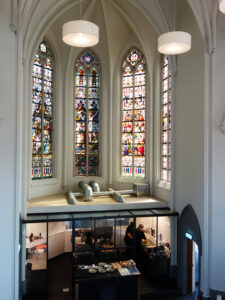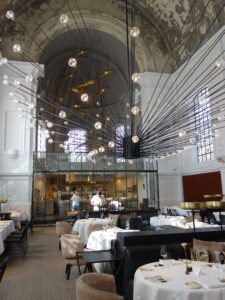
Fig. 1. Meeting centre DePetrus, Vught. View towards the entrance, 2019. Author: Maria Arno
Historical sacred objects constitute an important part of collective memory and provide a sign of spiritual continuity in a given society. Due to the lack of believers and too high maintenance costs, churches in many European cities are purchased by private individuals who intend to transform them into cultural, residential, or service facilities. The issue of changing the function of sacred space and adapting sacred buildings for other purposes constitutes a multifaceted problem. The current fate of such objects exemplifies the process of desacralization and secularization of Europe.

Fig. 2. Restaurant Onze Kerk, Hooge Zwaluwe. Restaurant kitchen and altar in the place of the former presbytery, 2019. Author: Maria Arno
The works’ main purpose was to expand the knowledge on the adaptation of sacral buildings for secular purposes on the example of selected implementations conducted in Western Europe. Another aim of the work is to determine the directions of good practice, recommendations, and conclusions regarding the adaptation of sacred buildings for secular functions. It was important to demonstrate possible solutions for adaptations that cause no profanation to holy places and cause no cognitive dissonance. These solutions should, if necessary, allow the object to be re-sacralized in the future. They combine a new function with the identity of a given place and its historical, cultural, and sacral values. Another goal was to analyze and use narrative research in the process of adapting sacral buildings. The narrative method is a holistic approach to architecture. It treats an architectural work as a product of culture embedded in mystery, culture, time and space. To a large extent, it takes into account the aesthetic, but also ethical evaluation, owing to the conclusion that the form implies value. Such a narrative approach seems justified in undertaking architectural and conservation activities aimed at preserving and maintaining monuments. Narrative research in sacral spaces can indicate an adequate and appropriate direction for the analysis and design process. It is an innovative method that can help arrive at an adequate secular destiny without desecrating a place of special religious significance and maintaining cultural identity. This holistic, universal tool combines not only aesthetic but also philosophical, ethical, and semantic categories. The narrative method can provide a useful tool for transforming, analyzing, and designing such objects.
The material scope of the study includes Christian churches (Catholic and Protestant), which are under conservation protection. The selected examples of adapting these objects to secular functions were implemented within the last 20 years. The territorial scope of the study covers Western Europe (the Netherlands, Germany, Belgium), as the adaptation phenomenon is widespread there. Therefore, numerous examples of the adaptation of former religious worship places can be indicated in this area, whereas selected acceptable design solutions may be implemented elsewhere. Examples of adaptation implemented in Poland within its current borders are also presented in the study; these, however, do not constitute a case study in this work.
The following research hypotheses were formulated in this study:
- Preserving the sacral function in a part of the building, sharing the church building with another Christian community, or adapting it to a function related to broadly understood culture and social or charitable activities may be seen as one of the possible and appropriate solutions to preserve the symbolic, cultural, and historical layer.
- The issue of adaptation of religious worship monuments is worth analyzing and developing in various aspects (conservation, cultural, sacral, with an account to the values of a given religious community) by applying the narrative method.
Moreover, the following research questions were posed in the dissertation:
- Which newly added function is acceptable if the sacred, cultural, and historical value of the sacred object is to be preserved?
- How to adapt the former temple for secular functions so as not to commit profanation?
- Is it possible in the future to recover the sacral function (re-sacralize) of religious places that currently serve secular functions? Will interventions in the internal structure of the building allow the object to perform sacral functions in the future, say in 50 or 100 years?
The issue of transforming places of worship is hardly a new phenomenon. The growing secularization and depopulation of some regions, the lack of believers and the shrinking possibilities to finance sacral buildings give raise to the need to discuss the future functions of unused, abandoned former places of worship and to indicate possible adequate directions and architectural solutions. Historical examples provide evidence that sacral buildings were undergoing constant transformations over the centuries, thanks to which various objects of sacred architecture have survived to our times. Adaptation may be seen as a possible action aimed at maintaining historic sacral buildings in a proper condition and preserving religious heritage for future generations.

Fig. 3. Restaurant The Jane. View of the kitchen in the place of the former presbytery, Antwerp, 2019. Author: Maria Arno
The research and analyses presented in the above work confirm that the future re-sacralization of religious worship places, which today have secular functions, is possible. The condition to be met is to maintain the sacral function in a part of such a building while sharing space with another Christian community or adapting it to a function related to the broadly understood cultural or social and charity activities. This solution creates new value through temporary use; thus, it is possible to check whether a given function is suitable for a given object. While the functions may be temporary, the effects may be long-lasting.
The research presented in the work exemplified that secular law often fails to coincide with church law. Hence, a conflict of interests arises between the institution of the Church as such and the conservator of monuments, whose main task is to protect material values and historic tissue. For instance, the Catholic Church is based on the Code of Canon Law, which has no legal force. As a result, retaining elements of the interior furnishings of the temple during adaptation may cause profanation of movable and immovable things, such as universally respected signs and symbols. The church’s decisions to demolish the temple or destroy the altars or other historic but consecrated liturgical elements go against the position of the conservator of monuments. Therefore, the question arises: what values, tangible or intangible ones, should be protected first during the adaptation of the church to secular functions? Should the values of material culture be given priority over the semantic-meaningful values of sacral architecture? The research shows that sacral objects cannot only be considered in the category of material values, due to the fact that the basic value of a sacral object (temple) refers to its cult function.
The issue of adapting sacral objects to secular functions is of multifaceted and complex nature. The main assumption of the above work was to determine how and into what function a sacred object can be transformed so as not to cause profanation to the place of worship. Moreover, it was aimed at determining which adaptation forms are consistent with conservation and theological conditions and cause no cognitive dissonance in people who respect Christian values.
MARIA ARNO, PhD, Architect, Academic teacher and researcher at Warsaw University of Technology, Faculty of Architecture, Department of Architectural and Urban Design, Studio of Sacred and Monumental Architecture. Member of the international non-governmental organization Future for Religious Heritage (FRH). Her professional practice is related to sacred and monumental architecture. Author of numerous articles and scientific publications. In her doctoral thesis “Adaptation of historical sacred objects to secular functions on the example of selected Western European projects with the use of the narrative method” examines how to adapt former churches to secular function and which new function is appropriate to preserve the historical, sacred and cultural value without causing profanation with the possibility of re-sacralisation in the future using narrative approach to the heritage. The thesis received three reviews with distinction and was defended with distinction in December 2023.
https://orcid.org/0000-0001-6794-2578
https://www.linkedin.com/in/maria-arno/
The link to Phd https://www.bip.pw.edu.pl/index.php/Postepowania-w-sprawie-nadania-stopnia-naukowego/Doktoraty/Wszczete-po-30-kwietnia-2019-r/Rada-Naukowa-Dyscypliny-Architektura-i-Urbanistyka/Maria-Arno/Rozprawa-doktorska (pp. 281-300 in English)





Follow us: